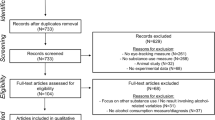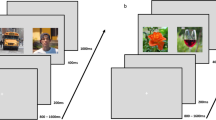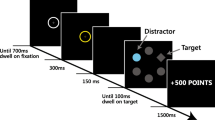Abstract
Rationale
While persons at risk for alcohol dependence by virtue of heavy drinking patterns or family history (FH) of alcohol use disorders have exhibited differential alcohol responses on a variety of measures, few studies have examined alcohol's effects on eye movements in these subgroups.
Objectives
The purpose of this study was to (1) conduct a placebo-controlled, dose-ranging study of alcohol's effects on eye movements and (2) examine the impact of these risk factors on oculomotor response to alcohol.
Methods
A within-subject, double-blind laboratory study was conducted in N = 138 heavy (HD; n = 78) and light social drinkers (LD; n = 60) with self-reported positive (FH+) or negative (FH−) family history. Subjects participated in three laboratory sessions in which they consumed a beverage containing a high (0.8 g/kg) or low (0.4 g/kg) dose of alcohol or placebo. Smooth pursuit, pro-saccadic, and anti-saccadic eye movements were recorded before and at two intervals after alcohol consumption.
Results
Alcohol significantly impaired smooth pursuit gain and pro- and anti-saccade latency, velocity, and accuracy in a dose and time specific matter. HD and LD showed similar impairment on smooth pursuit gain and anti-saccade measures, but HD were less impaired in pro-saccade latency, velocity, and accuracy. FH+ and FH− subjects were equally impaired in nearly all pro- and anti-saccade measures, but FH+ were less impaired in smooth pursuit gain.
Conclusions
In sum, alcohol produced systematic impairment on oculomotor functioning, even at a non-intoxicating dose. Furthermore, high- and low-risk drinkers may be vulnerable to select performance deficits relative to eye movement task.




Similar content being viewed by others
References
Andreasen NC, Endicott J, Spitzer RL, Winokur G (1977) The family history method using diagnostic criteria. Reliability and validity. Arch Gen Psychiatry 34:1229–1235
Avila MT, Weiler MA, Lahti AC, Tamminga CA, Thaker GK (2002) Effects of ketamine on leading saccades during smooth-pursuit eye movements may implicate cerebellar dysfunction in schizophrenia. Am J Psychiatry 159:1490–1496
Blekher T, Miller K, Yee RD, Christian JC, Abel LA (1997) Smooth pursuit in twins before and after alcohol ingestion. Invest Ophthalmol Vis Sci 38:1768–1773
Blekher T, Christian JC, Abel LA, Yee RD (1998) Influences of chorion type on saccadic eye movements in twins. Invest Ophthalmol Vis Sci 39:2186–2190
Blekher T, Beard JD, O'Connor S, Orr WE, Ramchandani VA, Miller K, Yee RD, Li TK (2002a) Response of saccadic eye movements to alcohol in African American and non-Hispanic white college students. Alcohol Clin Exp Res 26:232–238
Blekher T, Ramchandani VA, Flury L, Foroud T, Kareken D, Yee RD, Li TK, O'Connor S (2002b) Saccadic eye movements are associated with a family history of alcoholism at baseline and after exposure to alcohol. Alcohol Clin Exp Res 26:1568–1573
Brumback T, Cao D, King A (2007) Effects of alcohol on psychomotor performance and perceived impairment in heavy binge social drinkers. Drug Alcohol Depend 91:10–17
Calhoun VD, Pekar JJ, Pearlson GD (2004) Alcohol intoxication effects on simulated driving: exploring alcohol-dose effects on brain activation using functional MRI. Neuropsychopharmacology 29:2097–2117
Conrod PJ, Peterson JB, Pihl RO, Mankowski S (1997) Biphasic effects of alcohol on heart rate are influenced by alcoholic family history and rate of alcohol ingestion. Alcohol Clin Exp Res 21:140–149
Cowley DS, Roy-Byrne PP, Radant A, Hommer DW, Greenblatt DJ, Vitaliano PP, Godon C (1994) Eye movement effects of diazepam in sons of alcoholic fathers and male control subjects. Alcohol Clin Exp Res 18:324–332
Dawson DA (2000) US low-risk drinking guidelines: an examination of four alternatives. Alcohol Clin Exp Res 24:1820–1829
Epstein AM, Sher TG, Young MA, King AC (2007) Tobacco chippers show robust increases in smoking urge after alcohol consumption. Psychopharmacology (Berl) 190:321–329
Fillmore MT, Vogel-Sprott M (1995) Behavioral effects of alcohol in novice and experienced drinkers: alcohol expectancies and impairment. Psychopharmacology (Berl) 122:175–181
Fillmore MT, Vogel-Sprott M (1996) Social drinking history, behavioral tolerance and the expectation of alcohol. Psychopharmacology (Berl) 127:359–364
First MB, Spitzer RL, Gibbon M, Williams JBW (1995) Structured clinical interview for DSM-IV axis I disorders—patient edition (SCID-I/P, Version 2.0). Biometrics Research Department-New York State Psychiatric Institute, New York
Flom MC, Brown B, Adams AJ, Jones RT (1976) Alcohol and marijuana effects on ocular tracking. Am J Optom Physiol Opt 53:764–773
Frezza M, di Padova C, Pozzato G, Terpin M, Baraona E, Lieber CS (1990) High blood alcohol levels in women. The role of decreased gastric alcohol dehydrogenase activity and first-pass metabolism. N Engl J Med 322:95–99
Gabrielli WF Jr, Nagoshi CT, Rhea SA, Wilson JR (1991) Anticipated and subjective sensitivities to alcohol. J Stud Alcohol 52:205–214
Gale BW, Abel LA, Christian JC, Sorbel J, Yee RD (1996) Saccadic characteristics of monozygotic and dizygotic twins before and after alcohol administration. Invest Ophthalmol Vis Sci 37:339–344
Gianoulakis C, Krishnan B, Thavundayil J (1996) Enhanced sensitivity of pituitary beta-endorphin to ethanol in subjects at high risk of alcoholism. Arch Gen Psychiatry 53:250–257
Goodwin DW, Powell B, Stern J (1971) Behavioral tolerance to alcohol in moderate drinkers. Am J Psychiatry 127:1651–1653
Holdstock L, de Wit H (1999) Ethanol impairs saccadic and smooth pursuit eye movements without producing self-reports of sedation. Alcohol Clin Exp Res 23:664–672
Iacono WG, Lykken DT (1981) Two-year retest stability of eye tracking performance and a comparison of electro-oculographic and infrared recording techniques: evidence of EEG in the electro-oculogram. Psychophysiology 18:49–55
Iwata N, Cowley DS, Radel M, Roy-Byrne PP, Goldman D (1999) Relationship between a GABAA alpha 6 Pro385Ser substitution and benzodiazepine sensitivity. Am J Psychiatry 156:1447–1449
Jantti V, Lang AH, Keskinen E, Lehtinen I, Pakkanen A (1983) Acute effects of intravenously given alcohol on saccadic eye movements and subjective evaluations of intoxication. Psychopharmacology (Berl) 79:251–255
Katsanis J, Taylor J, Iacono WG, Hammer MA (2000) Heritability of different measures of smooth pursuit eye tracking dysfunction: a study of normal twins. Psychophysiology 37:724–730
Katsanis N, Worley KC, Gonzalez G, Ansley SJ, Lupski JR (2002) A computational/functional genomics approach for the enrichment of the retinal transcriptome and the identification of positional candidate retinopathy genes. Proc Natl Acad Sci U S A 99:14326–14331
Khan SA, Ford K, Timney B, Everling S (2003) Effects of ethanol on anti-saccade task performance. Exp Brain Res 150:68–74
King AC, Byars JA (2004) Alcohol-induced performance impairment in heavy episodic and light social drinkers. J Stud Alcohol 65:27–36
King AC, Epstein AM (2005) Alcohol dose-dependent increases in smoking urge in light smokers. Alcohol Clin Exp Res 29:547–552
King AC, Houle T, de Wit H, Holdstock L, Schuster A (2002) Biphasic alcohol response differs in heavy versus light drinkers. Alcohol Clin Exp Res 26:827–835
King A, Munisamy G, de Wit H, Lin S (2006) Attenuated cortisol response to alcohol in heavy social drinkers. Int J Psychophysiol 59:203–209
Krystal JH, Petrakis IL, Krupitsky E, Schutz C, Trevisan L, D'Souza DC (2003) NMDA receptor antagonism and the ethanol intoxication signal: from alcoholism risk to pharmacotherapy. Ann N Y Acad Sci 1003:176–184
Lehtinen I, Lang AH, Jantti V, Keskinen E (1979) Acute effects of alcohol on saccadic eye movements. Psychopharmacology (Berl) 63:17–23
Levy DL, Lipton RB, Holzman PS (1981) Smooth pursuit eye movements: effects of alcohol and chloral hydrate. J Psychiatr Res 16:1–11
Malone SM, Iacono WG (2002) Error rate on the antisaccade task: heritability and developmental change in performance among preadolescent and late-adolescent female twin youth. Psychophysiology 39:664–673
McDowell JE, Dyckman KA, Austin BP, Clementz BA (2008) Neurophysiology and neuroanatomy of reflexive and volitional saccades: evidence from studies of humans. Brain Cogn 68:255–270
Meda SA, Calhoun VD, Astur RS, Turner BM, Ruopp K, Pearlson GD (2009) Alcohol dose effects on brain circuits during simulated driving: an fMRI study. Hum Brain Mapp 30:1257–1270
Mendelson JH, Mello NK (1966) Experimental analysis of drinking behavior of chronic alcoholics. Ann N Y Acad Sci 133:828–845
Mitchell MC (1985) Alcohol-induced impairment of central nervous system function: behavioral skills involved in driving. J Stud Alcohol Suppl 10:109–116
Moser A, Heide W, Kompf D (1998) The effect of oral ethanol consumption on eye movements in healthy volunteers. J Neurol 245:542–550
Muri RM, Nyffeler T (2008) Neurophysiology and neuroanatomy of reflexive and volitional saccades as revealed by lesion studies with neurological patients and transcranial magnetic stimulation (TMS). Brain Cogn 68:284–292
Nyberg S, Wahlstrom G, Backstrom T, Poromaa IS (2004) No difference in responsiveness to a low dose of alcohol between healthy women and men. Pharmacol Biochem Behav 78:603–610
Padmanabhapillai A, Tang Y, Ranganathan M, Rangaswamy M, Jones KA, Chorlian DB, Kamarajan C, Stimus A, Kuperman S, Rohrbaugh J, O'Connor SJ, Bauer LO, Schuckit MA, Begleiter H, Porjesz B (2006) Evoked gamma band response in male adolescent subjects at high risk for alcoholism during a visual oddball task. Int J Psychophysiol 62:262–271
Petrakis IL, Limoncelli D, Gueorguieva R, Jatlow P, Boutros NN, Trevisan L, Gelernter J, Krystal JH (2004) Altered NMDA glutamate receptor antagonist response in individuals with a family vulnerability to alcoholism. Am J Psychiatry 161:1776–1782
Pollock VE (1992) Meta-analysis of subjective sensitivity to alcohol in sons of alcoholics. Am J Psychiatry 149:1534–1538
Ramchandani VA, O'Connor S, Blekher T, Kareken D, Morzorati S, Nurnberger J Jr, Li TK (1999) A preliminary study of acute responses to clamped alcohol concentration and family history of alcoholism. Alcohol Clin Exp Res 23:1320–1330
Rueger SY, McNamara PJ, King AC (2009) Expanding the utility of the Biphasic Alcohol Effects Scale (BAES) and initial psychometric support for the Brief-BAES (B-BAES). Alcohol Clin Exp Res 33:916–924
SAMHSA (2007) National Survey on Drug Use and Health. Office of Applied Studies, Office of Applied Studies
Schuckit MA (1984a) Differences in plasma cortisol after ingestion of ethanol in relatives of alcoholics and controls: preliminary results. J Clin Psychiatry 45:374–376
Schuckit MA (1984b) Subjective responses to alcohol in sons of alcoholics and control subjects. Arch Gen Psychiatry 41:879–884
Schuckit MA (1994) Low level of response to alcohol as a predictor of future alcoholism. Am J Psychiatry 151:184–189
Schuckit MA (1998) Biological, psychological and environmental predictors of the alcoholism risk: a longitudinal study. J Stud Alcohol 59:485–494
Schuckit MA, Smith TL (1996) An 8-year follow-up of 450 sons of alcoholic and control subjects. Arch Gen Psychiatry 53:202–210
Selzer ML, Vinokur A, van Rooijen L (1975) A self-administered Short Michigan Alcoholism Screening Test (SMAST). J Stud Alcohol 36:117–126
Sutker PB, Tabakoff B, Goist KC Jr, Randall CL (1983) Acute alcohol intoxication, mood states and alcohol metabolism in women and men. Pharmacol Biochem Behav 18(Suppl 1):349–354
Vassallo S, Abel LA (2002) Ethanol effects on volitional versus reflexive saccades. Clin Experiment Ophthalmol 30:208–212
Vorstius C, Radach R, Lang AR, Riccardi CJ (2008) Specific visuomotor deficits due to alcohol intoxication: evidence from the pro- and antisaccade paradigms. Psychopharmacology (Berl) 196:201–210
Wegner AJ, Fahle M (1999) Alcohol and visually guided saccades: gap effect and predictability of target location. Psychopharmacology (Berl) 146:24–32
Wilkinson IM, Kime R, Purnell M (1974) Alcohol and human eye movement. Brain 97:785–792
Acknowledgements
We thank Drs. Sean O'Connor and Dingcai Cao for their valuable input with the eye tracker, data analysis, and manuscript preparation. We also thank Patrick McNamara for his technical assistance, conducting experimental sessions, and database management.
This research was supported by NIH grant R01-AA013746 and NCI Cancer Center Grant P30-CA14599. This publication was also made possible by Grant Number UL1 RR024999 from the National Center for Research Resources (NCRR), a component of the NIH and NIH Roadmap for Medical Research.
The experiments in this study comply with the current US laws and were in compliance with the Declaration of Helsinki for human subjects.
Author information
Authors and Affiliations
Corresponding author
Additional information
Work was performed at the Clinical Addictions Research Laboratory, University of Chicago.
Rights and permissions
About this article
Cite this article
Roche, D.J.O., King, A.C. Alcohol impairment of saccadic and smooth pursuit eye movements: impact of risk factors for alcohol dependence. Psychopharmacology 212, 33–44 (2010). https://doi.org/10.1007/s00213-010-1906-8
Received:
Accepted:
Published:
Issue Date:
DOI: https://doi.org/10.1007/s00213-010-1906-8




